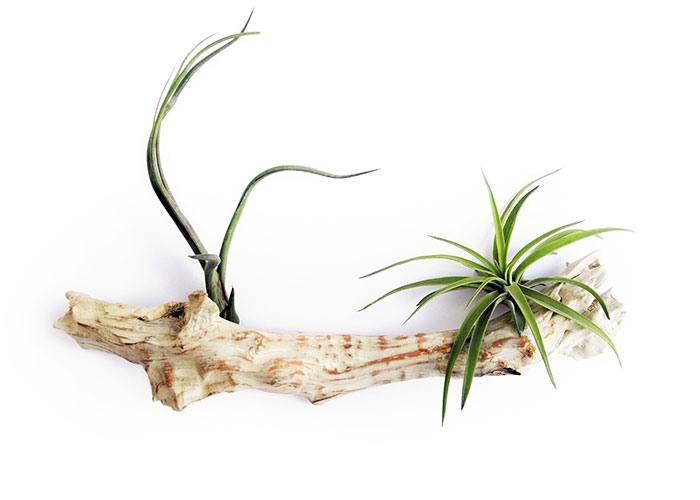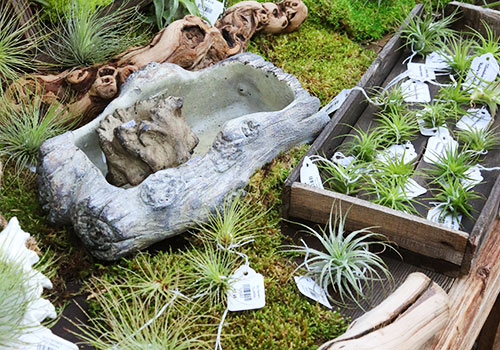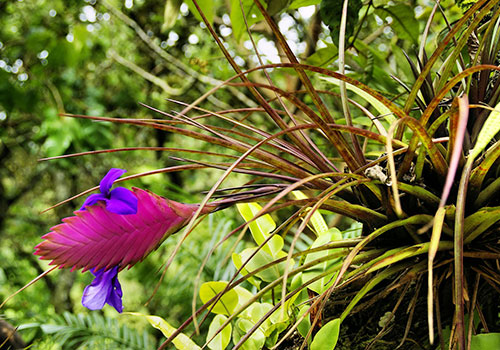Tillandsia: The Amazing Easy-Care Air Plant

Tillandsias are enjoying a well-deserved surge in popularity lately, but there are still many indoor gardeners who have yet to give this easy, fun, and rewarding houseplant a try.
Also known as “air plants,” tillandsias are unique in that they don’t require soil. This makes them extremely versatile indoor plants, and enthusiasts delight in finding fun and creative ways to display them. Whether artfully arranged inside a picture frame or simply grouped in a basket, tillandsias add instant vibrance and interest.
Best of all, they are very low-maintenance. While you might expect such unique plants to require a lot of specialized knowledge and care, nothing could be further from the truth! Air plants definitely play by different rules than anything else you can grow, but those rules are simple and easy to learn.
Once you know the basics of how to care for tillandsias, you’ll be ready to dive right in.
No Soil, No Problem
The most obvious difference between air plants and any other indoor plant is: there’s no need to plant them! In fact, they would die if you tried to. This makes them incredibly tidy and convenient housemates. No root pruning, no repotting, no spilled soil all over your kitchen counter. All they need is sunlight and water.
Tillandsias don't need a soil/substrate because of their unique specialized structures called "trichomes." These tiny silver hairs collect moisture and hold on to it long enough for the leaves to absorb all the water and nutrients the plant needs. Meanwhile, an air plant “roots” function purely as anchors.
And this seems to be quite a successful strategy! There are over 500 species of tillandsia. They hail from a huge swath of territory from the southern United States through central and south America and throughout the Caribbean islands. Some species of tillandsia can be found clinging to the misty upper branches of tropical rainforest trees, while others prefer cacti companions, or even the solitude of a craggy alpine cliff. Some even drift over the surface of shifting desert sands.
"Tillandsias don't need a soil/substrate because of their unique specialized structures called "trichomes."
Tillandsia Care Basics
If you can believe it, air plants are arguably even easier to grow than succulents. That is, once you understand their needs.
Air plants need periodic misting and/or soaking so that their leaves can absorb water, bright but not super-intense light, and good air circulation. Luckily, temperature isn’t usually a concern unless they are in a very sunny location or inside a glass container in full sun. They can adapt to a range of temperatures from 50 to 90 degrees fahrenheit.
The basics of tillandsia care look something like this:
- Bring your new tillandsia home.
- Let some tap water sit out for a while, so the chlorine evaporates, then plop your plant in there for an hour or so.
- Put it somewhere "bright-ish," but not in direct sunlight.
- Leave it alone for a couple of weeks.
- Repeat steps 2-4 and enjoy!
Keep in mind, you may need to adapt this basic plan a bit depending on: which specific kind of tillandsia you have, the temperature and moisture level in your home, and seasonal fluctuations.

Displaying Your Tillandsia
Tillandsias make for very versatile decor. Displaying them can be as simple as placing one artfully alongside other knick-knacks on a bookshelf, or as elaborate as designing a multi faceted arts and crafts project to take over an entire corner of your home. The choice is yours!
If you’d like to mount your air plants, they can be glued, tied, or wired to just about any surface you choose. A few popular examples include driftwood, seashells, and empty picture frames. They can even be made into living jewelry!
Just make sure that you’re using non-toxic glue (hot glue that is allowed to cool for a few seconds so that it doesn’t burn the plant works well), and avoid copper wire. Also, keep in mind that you will need to be able to easily water your air plants, and easily let them dry.
The one thing you should not do is try to plant your air plants in soil.
Soil is not their thing.
 Tillandsia Trouble-Shooting
Tillandsia Trouble-Shooting
While the instructions above should be all you need to get started, when indoor gardeners struggle with tillandsias, it’s usually for one of just a handful of reasons. Here’s what you can do if the basics don’t seem to be doing the trick.
- Make sure they have enough light. Often, humans and plants have different ideas about what “bright, indirect” light means. Many air plants prefer to be at least a few feet from the brightest windows, but that doesn’t mean they like to grow in the dark. Also, some species of tillandsia need more sun than others: it all depends on what conditions that particular species is adapted for. Try moving your tillandsia to a brighter location or putting it under a full-spectrum light and see if that helps.
- Soak thoroughly. Some advice out there recommends misting tillandsias. That might be enough for some of the most drought-tolerant desert species, but most air plants do best with at least an occasional deep-soak. If your air plant seems to be getting a bit crispy, try giving it a nice long bath for up to several hours.
- Give them a chance to dry off. Even though most tillandsias enjoy a good soak from time to time, they also don’t like to sit there constantly damp. This can be a problem especially for air plants that are displayed in glass globes where the air circulation is less than ideal. If your air plants live inside of globes, terrariums, or other containers, remove them for soaking and then let them dry fully somewhere with good air circulation before you put them back.
- Fertilize, but very sparingly. In nature, air plants get all the nutrition they need from the little bit of rotten stuff that dissolves in whatever water comes their way. Adding a little liquid fertilizer to your tillandsia’s soaking water in spring and summer can help it thrive and especially help it bloom, but a little bit goes a long way. There is special tillandsia fertilizer out there, and you can also use any liquid plant food, but at one-quarter strength. As an alternative, if you have access to it, you can use pond or aquarium water for a good soak instead of using synthetic fertilizer.
"Often, humans and plants have different ideas about what “bright, indirect” light means."
Blooms & Babies
Tillandsias are well worth growing for their regular foliage alone, but these plants are absolutely stunning when they bloom. Depending on the species, the foliage around tillandsia flowers can blush any number of amazing sunset colors before, during, and after a bloom, and the display can last weeks or even months.

To help your tillandsias bloom, make sure you’re following all of the care tips above, especially the ones about providing enough light and fertilizing regularly through the spring and summer. Air plants will typically bloom within one to two years of being purchased if they are in ideal conditions. But they can also hang out much longer without blooming if the conditions are just okay.
Almost as remarkable as a tillandsia in bloom is the cloning process that follows. As the flowers fade, you’ll see tiny baby plants called “pups” appear, growing from the base of the mother plant. Depending on the species, one plant can produce two to eight pups at a time.
Each tillandsia blooms only once in its life, so as the pups grow, the mother plant will slowly begin to die. How quickly this happens, again, depends on the species. In some cases, the mother plant can go on living for several years. Regardless, you will be left with two to eight new air plants to replace the one you lost!
Pups can be removed from the mother plant once they are one-third to one-half her size. You can remove them by twisting them away from the mother with your hands, or by cutting them at the base with a sharp knife. Alternatively, you can leave them attached to grow as an attractive cluster.
"They will happily serve as leafy companions, regardless of what kind of schedule you keep."
An Air Plant for Every Home
Tillandsias can brighten up whatever nooks and crannies are available in the tiniest of apartments, and they can also be clustered in stunning displays for larger spaces. Even if you don’t have the ideal bright light for them naturally, they will grow well under full-spectrum lights. And since they only need periodic attention, they will happily serve as leafy companions, regardless of what kind of schedule you keep. Given how versatile and resilient air plants are, we think just about every indoor gardener should consider keeping at least one.
